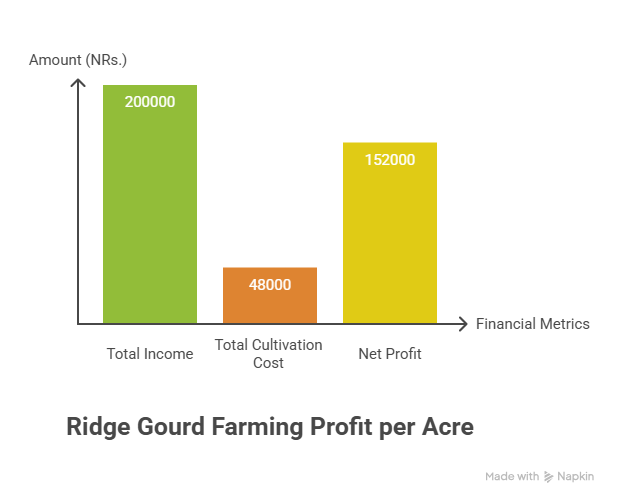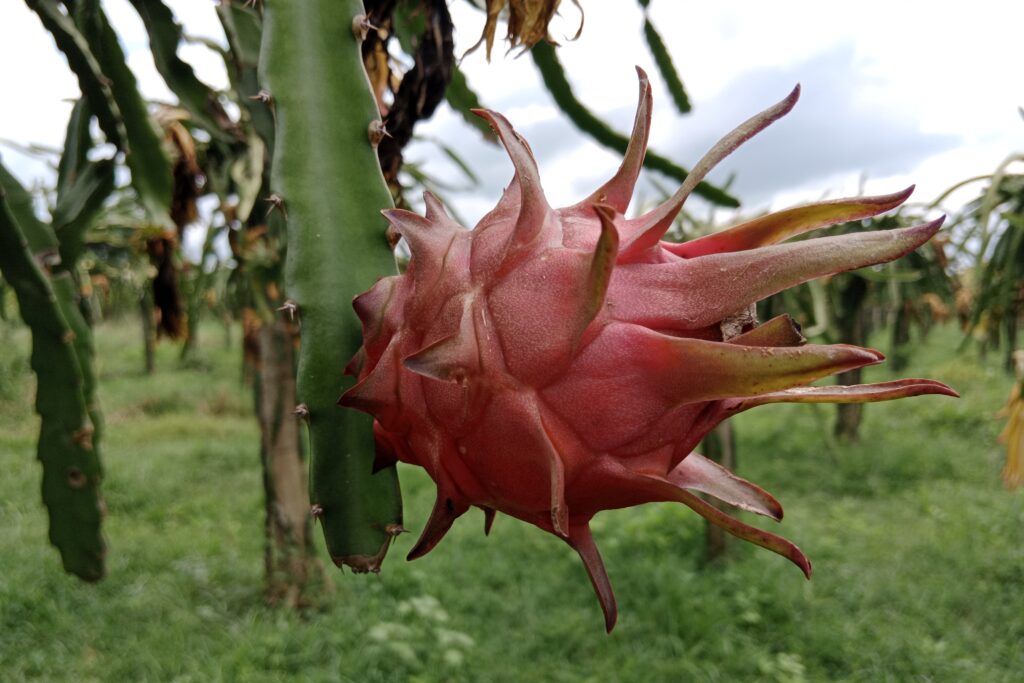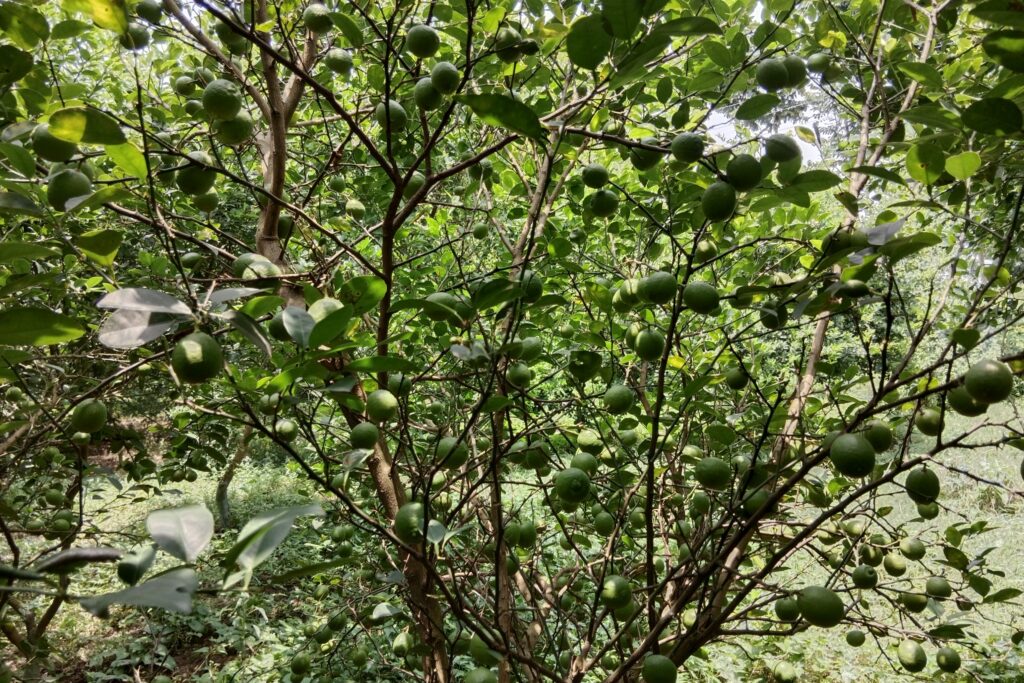Ridge Gourd Farming
Ridge gourd (Luffa acutangula) farming is a commercially important vegetable cultivation practice known for its high productivity and market demand. It thrives in warm climates, requires well-drained soils, and responds well to proper nutrient, irrigation, and pest management.
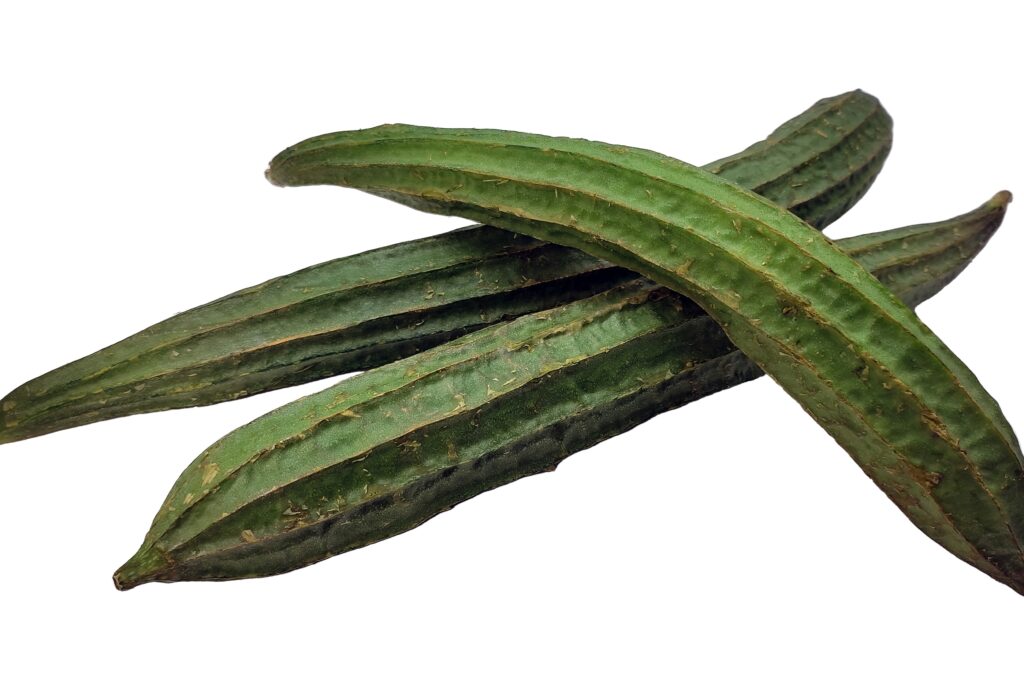
With appropriate agronomic practices, ridge gourd cultivation offers farmers consistent yields and significant economic returns, making it a profitable option in vegetable farming systems.
Ridge gourd farming is emerging as a highly lucrative agricultural venture, offering substantial financial returns for small and large-scale farmers alike. With proper cultivation practices, a single acre can generate a total income of NRs. 200,000 against the total cultivation cost of NRs. 48,000, resulting in a net profit of NRs. 152,000.
This translates into an impressive Return on Investment (ROI) of 316.67%, meaning that for every NRs. 100 invested, a farmer can earn a net profit of NRs. 316.67 after recovering the initial costs. Such figures clearly demonstrate the potential of ridge gourd farming profit per acre, making it an attractive option for maximizing returns in vegetable cultivation.
Land Preparation
Land should be prepared to a fine tilth to ensure proper drainage and aeration, which are essential for healthy root development. This involves deep first plowing to break up hardpan, followed by 2–3 harrowings to break clods and level the field, and finally forming raised beds or basins to facilitate irrigation and prevent waterlogging.
Soil Type
Ridge gourd grows best in well-drained sandy loam to loamy soils rich in organic matter, with an ideal pH range of 6.0 to 7.0, while heavy, water-retentive clay soils should be avoided as they can promote root rot diseases.
Climatic Requirements
Ridge gourd is a warm-season crop that requires a long, hot growing period, thriving best at temperatures between 25–35°C, as frost can severely damage the plants. While it can be cultivated in both arid and humid regions, consistent moisture is essential, though excessive rainfall during flowering may hinder pollination. Full sunlight is also necessary to ensure vigorous growth and achieve high yields.
Major Cultivars
| Category | Cultivars / Types | Key Characteristics |
| Popular Indian Varieties | Pusa Nasdar, Satputia, Coimbatore Long, PKM 1, Arka Sumeet, Konkan Harita | Chosen based on specific region, yield potential, and fruit quality. |
| Hybrids | Several F1 hybrids (from various seed companies) | High-yielding, offer better disease resistance and greater uniformity. |
Propagation
Ridge gourd is propagated sexually through seeds.
Seed Rate per Acre
Approximately 1.5 to 2 kg of seeds are required per acre. The rate may vary slightly based on the seed size, germination percentage, and spacing.
Nursery Management
Although direct sowing is common, raising ridge gourd seedlings in a nursery allows for better management and an earlier harvest. Seeds are sown in protrays or small pots filled with sterile potting mix, and the nursery should be protected from heavy rain and extreme cold. Germination typically occurs within 4–7 days, and seedlings with 2–3 true leaves, about 2–3 weeks old, are hardened before being transplanted to the main field.
Planting
a). Planting Season
The main planting seasons for ridge gourd are spring-summer (February–March) and monsoon (June–July), while in regions with mild winters, it can also be cultivated during autumn.
b). Spacing
A common planting spacing for ridge gourd is 2 × 2 meters between pits.
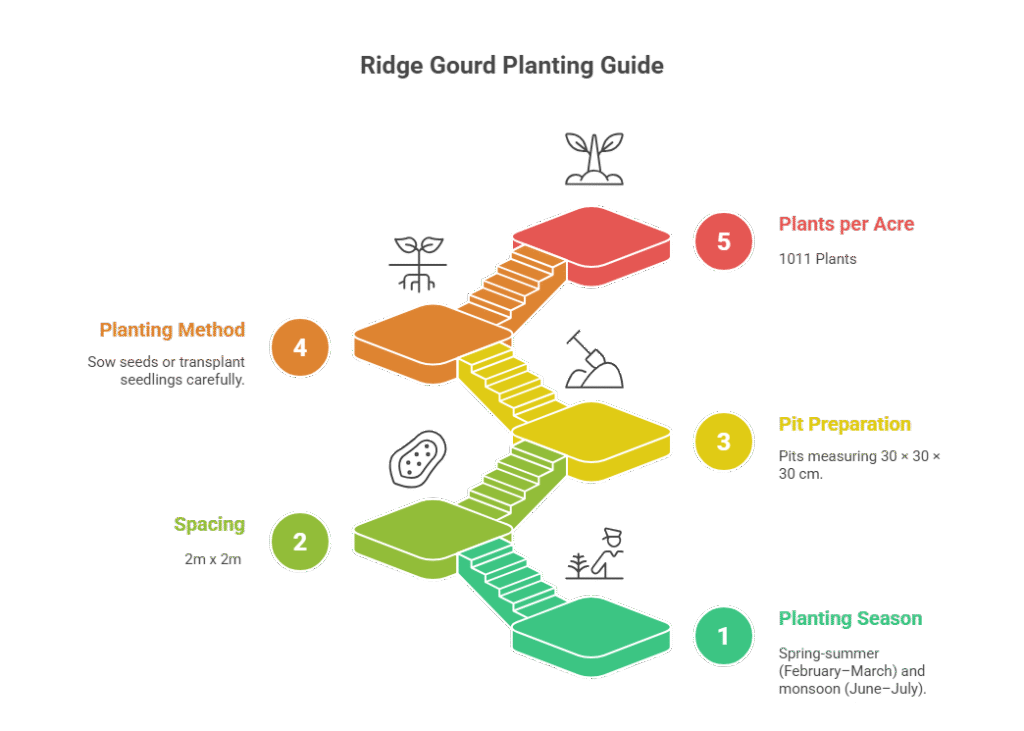
c). Pit Preparation
Pits measuring 30 × 30 × 30 cm are dug and filled with a mixture of topsoil and well-decomposed farmyard manure or compost.
d). Planting Method
3-4 seeds are sown directly per pit at a depth of 2-3 cm. After germination, they are thinned to retain the 2 strongest seedlings per pit. Alternatively, 1-2 healthy nursery-raised seedlings are transplanted per pit.
e). Number of Plants per Acre
With a planting spacing of 2 × 2 meters, approximately 1,011 ridge gourd plants can be grown per acre.
Intercropping
Due to its widely spaced vine growth habit, intercropping with short-duration crops such as radish, spinach, coriander, or lettuce is a viable practice during the initial growth stages of cultivation; this approach maximizes land use efficiency and generates additional income for growers.
Irrigation
Ridge gourd requires consistent moisture, particularly during the critical flowering and fruiting stages to ensure successful development. Irrigation should begin with a light watering immediately after sowing or transplanting, followed by a schedule of every 4-5 days during the summer and every 10-15 days during the winter in its vegetative stage.
It is crucial to avoid any water stress during flowering and fruit development; employing drip irrigation is highly beneficial for conserving water and preventing foliar diseases. However, waterlogging must be avoided at all costs.
Fertilizer and Manure
| Application Type | Timing | Recommendation | Quantity per Acre |
| Basal Dose (Main Application) | Before planting | Farm Yard Manure (FYM) / Compost | 8-10 tonnes |
| Nitrogen (N), Phosphorus (P₂O₅), and Potash (K₂O) | 25 kg N, 50 kg P₂O₅, 25 kg K₂O | ||
| Biofertilizers | Before or during planting | Azospirillum, Phosphorus Solubilizing Bacteria (PSB), and Potash Mobilizing Bacteria | 800g of each |
| Top Dressing | At the time of vining | Nitrogen (N) | 25 kg N |
| At the onset of flowering | Nitrogen (N) | 25 kg N |
Weed Control
Weeds compete with ridge gourd plants for nutrients and water, particularly during the early growth stages, so effective management is essential. Manual weeding should be carried out 2–3 times within the first month, while mulching with organic materials such as paddy straw or plastic mulch helps suppress weed growth and conserve soil moisture.
Additionally, pre-emergence herbicides like Pendimethalin can be applied immediately after sowing but before weed emergence, strictly following label instructions for safe and effective use.
Inter Culture Operation
Training ridge gourd vines on a bower system (pandal) is the most common and effective practice, as it enhances fruit quality, facilitates spraying and harvesting, and helps reduce disease incidence. While pruning is not essential, selectively removing some lateral branches in overly dense canopies improves air circulation and light penetration, further minimizing the risk of diseases.
Flowering and Fruit Management
Flowering
Ridge gourd is a monoecious crop, meaning it produces separate male and female flowers on the same plant. Successful pollination is crucial for fruit development, and bees along with other pollinating insects play a vital role in this process. Maintaining a pollinator-friendly environment around the field is therefore important for ensuring good fruit set.
Fruit Set
Poor fruit set in ridge gourd is often linked to a shortage of pollinators or unfavorable conditions such as excessively high temperatures. In protected cultivation, hand pollination—using a small brush to transfer pollen from male to female flowers—can be practiced to improve fruit set and overall yield.
Management Practices
Adequate irrigation and balanced nutrient supply during flowering and fruit development stages are critical to prevent flower drop and to support healthy pod formation. Proper care at this stage ensures better fruit quality and higher productivity.
Pest and Disease Management
Common Pests
Fruit Fly
The fruit fly is the most destructive pest of ridge gourd, as it lays eggs inside tender fruits, causing rotting and making them unmarketable. Management includes installing cue-lure traps to attract and kill male flies, bagging young fruits with paper or polythene covers, and removing infested fruits from the field. For chemical control, spraying Malathion 50% EC at 2 ml per liter of water or Spinosad 45% SC at 0.3 ml per liter of water is effective in reducing fruit fly damage.
Red Pumpkin Beetle
The red pumpkin beetle attacks young seedlings and leaves, chewing holes that weaken the plants and reduce vigor. Light infestations can be managed by hand-picking beetles in small plots. For chemical control, dusting Carbaryl 10% DP at 20–25 kg per acre or spraying Cypermethrin 25% EC at 1 ml per liter of water provides effective protection.
Aphids and Whiteflies
Aphids and whiteflies suck plant sap, causing curling and yellowing of leaves, and also act as vectors of viral diseases, leading to heavy yield losses if not controlled in time. For management, foliar sprays of Imidacloprid 17.8% SL at 0.3 ml per liter of water or Acetamiprid 20% SP at 0.25 g per liter of water are recommended. Early monitoring and timely spraying are essential for effective suppression.
Common Diseases
Powdery Mildew
Powdery mildew appears as a white, powdery fungal growth on the surface of leaves, which reduces photosynthesis and weakens the plant. It spreads quickly in dry, warm conditions. Management includes improving air circulation and spraying fungicides such as Hexaconazole 5% EC at 1 ml per liter of water or Wettable Sulfur 80% WP at 2–3 g per liter of water, applied at 10–14 day intervals when symptoms first appear.
Downy Mildew
Downy mildew is identified by yellow spots on the upper leaf surface and a whitish-gray fungal growth on the underside. It thrives under humid and cool conditions, causing premature leaf drop and reduced yield. Effective management includes spraying Mancozeb 75% WP at 2–2.5 g per liter of water or Metalaxyl + Mancozeb (72% WP) at 2 g per liter of water every 10–12 days during favorable conditions.
Damping Off
Damping off affects seedlings, causing them to rot at the base and collapse, often leading to heavy losses in nurseries. It is favored by overwatering, poor drainage, and contaminated soil. Preventive measures include using well-drained seedbeds and treating seeds with fungicides such as Carbendazim 50% WP at 2 g per kg of seed or Thiram 75% WP at 2–3 g per kg of seed before sowing.
Harvesting
Harvesting of ridge gourd should be done when the fruits are young, tender, and green, usually 7–10 days after fruit set, before the fibers start to develop and harden. Regular harvesting at intervals of 2–3 days using a sharp knife or secateurs is recommended to avoid damaging the vines and to encourage continuous fruiting. Overripe fruits, which become fibrous and unsuitable for consumption, can still be utilized for processing into sponge (loofah).
Yield
The yield of ridge gourd largely depends on the cultivar, season, and management practices, with a well-managed crop producing between 8,000 and 12,000 kg per acre.
Cost of Investment Per Acre for Ridge gourd Farming
| S.N. | Categories | Cost (NRs.) |
| 1 | Land Preparation | 15,000 |
| 2 | Seed | 1,000 |
| 3 | Seed Sowing | 2,000 |
| 4 | Fertilizers and Manure | 8,000 |
| 5 | Irrigation | 5,000 |
| 6 | Weed Control (Pre & Post-emergence) | 3,000 |
| 7 | Pest & Disease Control | 3,000 |
| 8 | Harvesting | 6,000 |
| 9 | Miscellaneous Costs | 5,000 |
| Total Cost | 48,000 |
Income per acre for Ridge Gourd Farming
| Particulars | Estimated Yield (kg/acre) | Market Price (NRs/kg) | Total Income (NRs.) |
| Ridge Gourd Yield | 10,000 | 20 | 200,000 |
Analysis of Ridge Gourd Farming Profit Per Acre
| Particulars | Amount (NRs.) |
| Total Income | 200,000 |
| Total Cost of Cultivation | 48,000 |
| Net Profit (A – B) | 152,000 |
| Return on Investment (ROI) | 316.67% |
The analysis indicates that ridge gourd farming is a highly profitable venture, yielding an exceptional net profit of approximately NRs. 152,000 per acre, with a remarkably high Return on Investment (ROI) of 316.67%, meaning for every NRs. 100 invested, a farmer can earn a net profit of NRs. 316.67 after recovering the initial costs.
Crop Calendar for Ridge Gourd Farming
This calendar provides a month-by-month guide for the two primary planting seasons. Timings are approximate and may shift by 1-2 weeks based on your specific regional climate and weather conditions.
| Month | Growth Stage | Key Activities & Operations |
| Season 1: Spring-Summer Crop (Sown Feb-Mar) | ||
| February | Land Preparation & Sowing | Land Prep: Deep plowing, harrowing, forming raised beds. Apply full basal dose of FYM (8-10 t/acre) and fertilizers (25-50-25 kg NPK/acre). Sowing: Sow seeds directly in pits (2x2m spacing) by mid-to-late February. |
| March | Germination & Early Growth | Seedlings emerge. Thin to 2 strongest plants per pit. Begin light, regular irrigation (every 4-5 days). Start weeding and monitor for red pumpkin beetles. |
| April | Vegetative Growth (Vining) | Top Dressing (1): Apply 25 kg N/acre at the start of vining. Train vines onto the bower (pandal) system. Continue irrigation and pest monitoring. |
| May | Flowering & Fruiting | Top Dressing (2): Apply another 25 kg N/acre at flowering onset. Critical: Ensure consistent moisture. Begin fruit fly management (traps, bagging). First harvest begins by end of May. |
| June – July | Harvesting | Main Harvest Period: Harvest tender fruits every 2-3 days. Continue intensive irrigation and pest/disease (powdery mildew, fruit fly) control. |
| August | End of Cycle | Final harvest. Remove old crop residues from the field. Prepare for next crop. |
| Season 2: Monsoon/Kharif Crop (Sown Jun-Jul) | ||
| June | Land Preparation & Sowing | Land Prep: Prepare land after pre-monsoon showers. Apply full basal dose of fertilizers and manure. Sowing: Sow seeds by mid-June to early July. |
| July | Germination & Early Growth | Seedlings establish. Ensure proper drainage to avoid waterlogging. Thinning and weeding are critical. |
| August | Vegetative Growth (Vining) | Top Dressing (1): Apply 25 kg N/acre at vining. Train vines. Monitor for diseases fostered by humidity (e.g., downy mildew). |
| September | Flowering & Fruiting | Top Dressing (2): Apply 25 kg N/acre at flowering. Ensure pollination is not hindered by heavy rains. Begin fruit fly management. First harvest begins. |
| October – November | Harvesting | Main Harvest Period: Regular harvesting every 2-3 days. Irrigation frequency reduces as temperatures drop. Protect from early frosts in northern regions. |
| December | End of Cycle | Final harvest. Remove crop residues. Plan for crop rotation. |
Also Read: Spine Gourd Farming Profit per Acre
Also Read: Bottle Gourd Farming Profit per Acre
Sources
Food and Agriculture Organization (FAO)
University of California Agriculture & Natural Resources (UC ANR)
European Plant Protection Organization (EPPO)
Punjab Agricultural University (PAU)
Tamil Nadu Agriculture University (TNAU) – Agritech portal
Indian Council of Agricultural Research (ICAR)
Nepal Agricultural Research Council (NARC)
U.S. Department of Agriculture (USDA).
Ministry of Agriculture and Livestock Development (Nepal)
Disclaimer: This crop farming profits assume optimal conditions. Actual results may vary depending on climate, market prices, and farm management practices.

